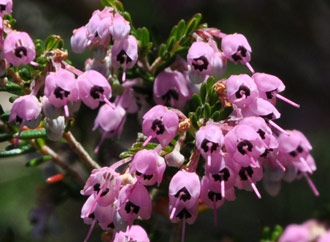Erica canaliculata
Erica canaliculata Andrews
Family: Ericaceae
Common names: channelled heath
Introduction
Erica canaliculata is a most impressive species that grows into a small tree that is covered with thousands of small pink flowers in summer. This species produces lovely displays along forest margins or in the thick fynbos-filled valleys of the southern Western and Eastern Cape.

Description
Description
Erica canaliculata is a large, erect shrub up to 2 or 3 m high, sometimes developing into a small tree up to 5 m tall.It is well branched and covered with small green leaves giving a fine, soft texture. The main stem develops into a trunk up to 100 mm in diameter on large specimens. The bark is grayish-brown and has grooves in the old stems.
This species produces a profusion of small cup-shaped pink flowers in clusters near the ends of its branches mainly during summer (from November to February). The flowers are distinguished by their very long styles, which protrude from the flower. Another feature is that the calyx has four lobes instead of four separate sepals and the anthers are muticous, which means they do not have appendages such as awns.
The fresh flowers have a strong fragrance, which becomes very noticeable while working with cut specimens. Its scent is a bit musty, with a sweet soapy smell, not unpleasant yet not exactly pleasant either.
Conservation Status
Status
Erica canaliculata is common along the southern Cape coastal plains and as such has been classified in the Red List as Least Concern.
Distribution and habitat
Distribution description
Erica canaliculata grows along the coastal plains and valleys from George to Humansdorp in the Western and Eastern Cape. This species is found on moist flats and lower slopes . It tolerates full sunlight in the open where it will be more compact in growth reaching a height of about 3 m. It is however more often found along forest margins where it grows into a small tree 5 m tall. It grows in poor, well drained, acidic soils derived from weathered quartzite.
Derivation of name and historical aspects
History
This species is named from the Latin word, 'canaliculatus' which means channelled, referring to the grooves in its old stems. Plants were collected by European collectors and grown in Europe in the nineteenth century, and specimens are still in cultivation at the Belvedere Palace Gardens in Vienna after 200 years. At this garden plants are grown in large pots and pruned into the shape of a lollipop.
Ecology
Ecology
It appears to be pollinated by bees and small insects.

Uses
Use
Erica canaliculata is a very showy species when in flower. It is recommended as a strong growing, reliable garden plant and is easy to maintain in average Mediterranean conditions and will also grow well as a large pot plant.
This species is ideal for a fynbos garden or even for a semishade garden as long as it gets some direct sunlight in the day. Flowering branches make an excellent, long-lasting cutflower.

Growing Erica canaliculata
Grow
Erica canaliculata is easily grown from fresh seed which remains optimally viable for approximately five years after which it begins to lose its viability by degrees. Seed should be sown in late summer or autumn with germination greatly enhanced by the application of smoke which mimics the conditions in nature. Seed is sown onto a well-drained, slightly acidic growing medium consisting of a combination of river sand and well decomposed pine bark in roughly equal proportions. Seed germinates in about six weeks, emerging as tiny, delicate plantlets that must be lightly watered with a watering can. Let the seedlings grow to about 10 mm tall before pricking them out into small individual pots. Young seedlings are encouraged to grow by feeding them every week with a diluted organic fertilizer. Seedlings grow slowly and will only be big enough after twelve months when they may be planted into the garden. It is advisable to plant out during the cooler autumn or early winter months to allow the plants to establish before the onset of summer.
Erica canaliculata is rooted from cuttings in autumn or spring in multi-trays on heated benches under mist spray. Select small tip or heel cuttings about 20-30 mm long, taking thin wood from the previous season's growth. Heel cuttings are preferred where a short side shoot is removed from the stem. The base of the cutting is treated with a rooting hormone for semi-hardwood cuttings which are then placed into a rooting medium of 50:50 fine milled bark and polystyrene or perlite pellets.
Erica canaliculata grows very well in a large container, providing that the correct, well-draining growing medium is provided. Fynbos planting medium is made up of a combination of equal parts composted pine bark or pine needles and river sand. A little (20%) loam may also be added. It is a woody species, so regular pruning is recommended to keep the plants well branched and compact. Plants that are pruned are more presentable, last longer and produce more flowers.
Erica plants are adapted to living in poor soils, but, for best results, should be regularly fed with diluted organic liquid or small amounts of organic pellet fertilizers.
References
- Goldblatt, P. & Manning, J.C. 2000. Cape plants. A conspectus of the Cape flora of South Africa. Strelitzia 9. National Botanical Institute, Pretoria and Missouri Botanical Garden.
- Schumann, D. (Dolf) & Kirsten, G. (Gerard) 1992. Ericas of South Africa. Fernwood Press, Vlaeberg, Cape Town.
- http://www.sanbi.org/biodiversity/reddata.htm
- http://www.plantweb.co.za
Credits
Anthony Hitchcock
Kirstenbosch National Botanical Garden
March 2012
Plant Attributes:
Plant Type: Shrub
SA Distribution: Eastern Cape, Western Cape
Soil type: Sandy, Loam
Flowering season: Sporadic/All year
PH: Acid
Flower colour: Pink
Aspect: Full Sun
Gardening skill: Easy
Special Features:
Horticultural zones







Rate this article
Article well written and informative
Rate this plant
Is this an interesting plant?
Login to add your Comment
Back to topNot registered yet? Click here to register.